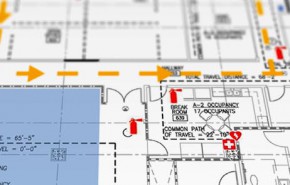In reaction to the events of September 11, 2001, the Federal Emergency Management Agency designated September as National Preparedness Month in 2004 to encourage all Americans to prepare for emergencies in their homes, businesses, schools, and communities. So this month at GAI, we’re taking an opportunity to highlight emergency response in the workplace.
The Federal Occupational Safety and Health Administration (OSHA) requires that all employers provide instructions for their workforce on emergency response. As an employer, you need to make sure your Emergency Action Plan (EAP) is specific to the types of emergencies you might encounter given the type of work you do. Consider natural disasters, fires, explosions, and workplace violence. If you have multiple offices in various locations, there may be a need to modify your EAP. For example, an office in Florida should address hurricane safety, while one in Oklahoma should cover tornados. A workplace that stores large quantities of hazardous substances should consider fires and spills, while a workplace in an office setting may not have to worry about such things.
It may seem daunting to create an EAP for your workplace, but it isn’t difficult. There are five critical items to include on any EAP, regardless of the type of workplace or number of employees.
It may seem daunting to create an EAP for your workplace, but it isn’t difficult. There are five critical items to include on any EAP, regardless of the type of workplace or number of employees:*
- Identify at least one person who is responsible for implementation and administration of the EAP. Also identify a backup person.
- Detail procedures that employees should take to report emergencies, such as using an office phone system, paging system, or fire alarm pull box. The goal is to ensure that all employees will be informed quickly if something happens that requires their immediate response. In addition, identify a person responsible for contacting local responders and make clear how they will do so.
- Provide information on evacuating the workplace, including primary and secondary evacuation routes, an assembly area for employees to gather one they have evacuated the building, and a process for accounting for employees after an evacuation. Don’t forget to address the needs of employees or visitors with disabilities, and also account for visitors.
- Provide information on how to shelter in place, including shelter locations in the building or work area and a process for accounting for employees once they reach the shelter.
- Determine which employees may perform medical or rescue duties. Local emergency responders are equipped to perform both of these tasks, but consider how long it might take for them to arrive. Many organizations train employees on first aid and cardio-pulmonary resuscitation. They are not required to render care and are trained to use their judgement as to whether or not to do so while waiting for responders.
*OSHA regulations provide an exemption for a workplace with 10 or fewer employees. In these situations, the EAP does not need to be in writing but can be communicated orally.
Once your plan is developed, you have three more critical actions to take—communicate the contents of the EAP to all employees, review/revise the EAP on a regular basis, and practice it.
- Include a review of the EAP in your new hire orientation process. Also review it with all employees any time it is revised. Formal training may be necessary depending upon the extent of the revisions, though an e-blast may be sufficient for minor revisions.
- Revise your EAP at least once per year. Your designated plan administrator should take the lead, with assistance from others as needed. Additional reviews should occur when significant events affect the EAP, including major staff changes and building remodeling.
- Practice your EAP at least once per year. If it is never practiced, even the best EAP is nothing but a piece of paper. Practicing helps make sure the EAP works as it is written. We often find errors when we run a drill that we wouldn’t have found otherwise. Practicing also helps employees know what to do. While it may seem obvious how to evacuate your workplace, in an emergency it’s common to panic. So practicing the EAP helps employees memorize what to do when panic sets in. (It’s why we teach our children simple memory aids like Stop, Drop and Roll). Also create various scenarios each time you practice so employees learn what to do in different situations. For example, block a primary building exit so they learn a different way out.
These tips will get you started on developing and implementing an EAP for any workplace. And remember to revisit them every September! More information can be obtained at a variety of websites, including the following:
- OSHA: https://www.osha.gov/SLTC/emergencypreparedness/index.html\
- Federal Emergency Management Agency: http://www.ready.gov/business
In our next blog, we’ll relay info to help your employees be prepared in their homes and communities!
![]() As Health & Safety Director, Bill Gourdie is responsible for spearheading initiatives that help GAI comply with all applicable health, safety, and environmental regulations; client requirements; and corporate policies and procedures in order to maintain the safest possible working conditions for all employees. He supports and advances GAI’s commitment to safety by coordinating the development, implementation, and continuous improvement of the company’s Safety & Health Program to enhance its effectiveness and improve performance results. Bill may be reached by phone at 412.399.5219.
As Health & Safety Director, Bill Gourdie is responsible for spearheading initiatives that help GAI comply with all applicable health, safety, and environmental regulations; client requirements; and corporate policies and procedures in order to maintain the safest possible working conditions for all employees. He supports and advances GAI’s commitment to safety by coordinating the development, implementation, and continuous improvement of the company’s Safety & Health Program to enhance its effectiveness and improve performance results. Bill may be reached by phone at 412.399.5219.


